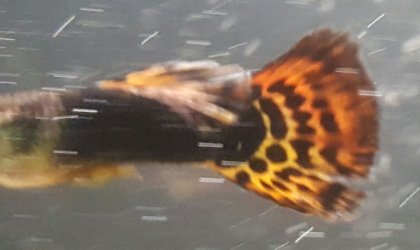I have a large tank, around 90 gallons. It's a peaceful community aquarium and has been for around 6 months. I brought in a new white male guppy and later found the aquarium I got it from had fish with ich. I caught it after seeing just a couple spots on two fish. I treated it with Microbe Lift Herbtana and it worked great, no more ich. However, during treatment I noticed a guppy with a little chunk out of his tail. Then another. Now most of my guppies have chunks missing or tears in their tails. Water parameters are all within the guppies normal zones.
All the guppies are male, I have nine of them. With them I have:
2 Scissortail Rasbora
4 Glass Catfish
2 female Platies
3 Panda Cory
2 Yoyo loach
1 Dojo loach
1 baby Albino bristlenose pleco
2 Candy cane Tetra
2 Neon Tetra
2 Penguin Tetra
2 Rummy nose Tetra
2 Glowlight Tetra
2 Black neon Tetra
2 Long fin serpae Tetra
1 Long fin Blue Danio
1 Longfin zebra Danio
Everyone was doing fine until recently. Could theyou possibly have fin rot, or is there a nipper in my tank? If I've got one, who is the culprit? I doubt my loaches or cories could be because they're very mellow and stay much lower than the gups. I had two male platies a month or so ago I caught chasing other fish and I moved the naughty boys. It's not the new gup because he's got it too. My Glowlight, neons, penguins, and rummynose school together and don't seem to bother anyone. Or if I have fin rot, what's the best method to treat them, and when, because they just finished their ich treatment. Everyone is well fed with granules, flakes, shrimp, and algae wafers. They get light during the day and dark at night. I have three filters that aerate the water.
All the guppies are male, I have nine of them. With them I have:
2 Scissortail Rasbora
4 Glass Catfish
2 female Platies
3 Panda Cory
2 Yoyo loach
1 Dojo loach
1 baby Albino bristlenose pleco
2 Candy cane Tetra
2 Neon Tetra
2 Penguin Tetra
2 Rummy nose Tetra
2 Glowlight Tetra
2 Black neon Tetra
2 Long fin serpae Tetra
1 Long fin Blue Danio
1 Longfin zebra Danio
Everyone was doing fine until recently. Could theyou possibly have fin rot, or is there a nipper in my tank? If I've got one, who is the culprit? I doubt my loaches or cories could be because they're very mellow and stay much lower than the gups. I had two male platies a month or so ago I caught chasing other fish and I moved the naughty boys. It's not the new gup because he's got it too. My Glowlight, neons, penguins, and rummynose school together and don't seem to bother anyone. Or if I have fin rot, what's the best method to treat them, and when, because they just finished their ich treatment. Everyone is well fed with granules, flakes, shrimp, and algae wafers. They get light during the day and dark at night. I have three filters that aerate the water.






